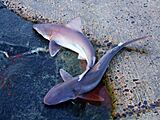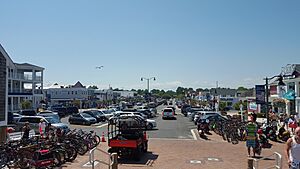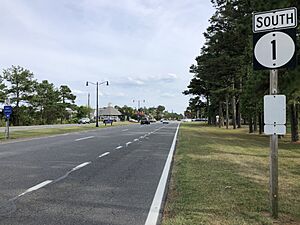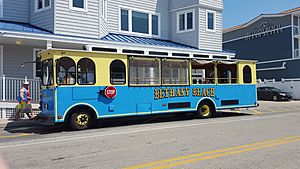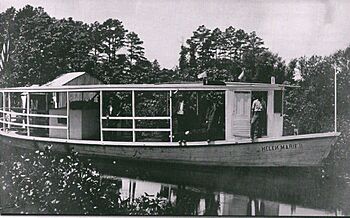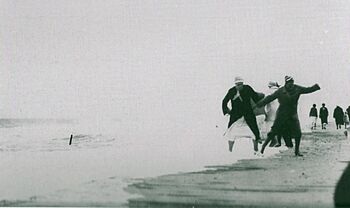Bethany Beach, Delaware facts for kids
Quick facts for kids
Bethany Beach, Delaware
|
|
|---|---|
|
Town
|
|
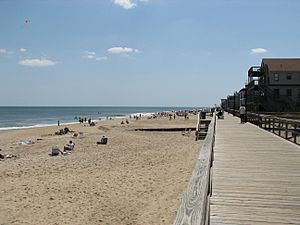
The Bethany Beach boardwalk in April 2006, prior to the 2008–09 construction of a new dune between it and the Atlantic Ocean.
|
|
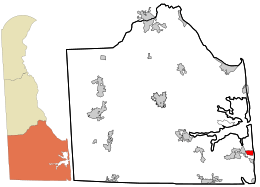
Location of Bethany Beach in Sussex County, Delaware.
|
|
| Country | United States |
| State | Delaware |
| County | Sussex |
| Incorporated | July 1, 1901 |
| Government | |
| • Type | Council-manager |
| Area | |
| • Total | 1.16 sq mi (3.01 km2) |
| • Land | 1.15 sq mi (2.97 km2) |
| • Water | 0.01 sq mi (0.04 km2) |
| Elevation | 7 ft (2 m) |
| Population
(2020)
|
|
| • Total | 954 |
| • Density | 831.01/sq mi (320.78/km2) |
| Time zone | UTC−5 (Eastern (EST)) |
| • Summer (DST) | UTC−4 (EDT) |
| ZIP code |
19930
|
| Area code(s) | 302 |
| FIPS code | 10-05690 |
| GNIS feature ID | 213638 |
| Website | http://www.townofbethanybeach.com |
Bethany Beach is a small town located in Sussex County, Delaware, United States. In 2020, about 954 people lived there. However, during the summer, the town becomes much busier, with around 15,000 vacationers visiting. It's part of the larger Salisbury, MD-DE area.
Bethany Beach, along with nearby South Bethany and Fenwick Island, is often called one of "The Quiet Resorts." This is partly because Delaware Seashore State Park is right next to it on the north side, keeping the area peaceful.
Even though it's small, Bethany Beach has many fun things to do for summer visitors. It has a short boardwalk named Joseph Olson, a wide sandy beach, hotels, restaurants, and vacation homes. Unlike some other beach towns, Bethany Beach is not on a separate island, so its neighborhoods stretch quite a bit inland.
Contents
Exploring Bethany Beach's Location
Bethany Beach is located at 38°32′22″N 75°03′19″W / 38.53944°N 75.05528°W. To its north is the Delaware Seashore State Park and Salt Pond. The Atlantic Ocean is to its east, South Bethany to its south, and Ocean View to its west.
The town covers about 1.2 square miles (3.01 square kilometers). Most of this area, about 1.1 square miles (2.97 square kilometers), is land, with a small part being water.
Beautiful Beaches
Bethany Beach has free public beaches along its eastern side. These beaches are watched over by professional lifeguards from the Bethany Beach Patrol during the summer. The patrol has 30 members and works every day from Memorial Day weekend to Labor Day, and on weekends in September. There's also a half-mile section of private beach within Bethany Beach that belongs to Sea Colony.
-
Bethany Beach is home to various wildlife, including sand sharks.
Bethany Beach Weather
The weather in Bethany Beach usually means hot and humid summers, and mild to cool winters. It has a humid subtropical climate, which is known as "Cfa" on climate maps.
| Climate data for Bethany Beach, Delaware | |||||||||||||
|---|---|---|---|---|---|---|---|---|---|---|---|---|---|
| Month | Jan | Feb | Mar | Apr | May | Jun | Jul | Aug | Sep | Oct | Nov | Dec | Year |
| Record high °F (°C) | 78 (26) |
86 (30) |
89 (32) |
92 (33) |
97 (36) |
102 (39) |
101 (38) |
101 (38) |
98 (37) |
92 (33) |
88 (31) |
77 (25) |
102 (39) |
| Mean daily maximum °F (°C) | 45 (7) |
48 (9) |
55 (13) |
65 (18) |
74 (23) |
83 (28) |
87 (31) |
85 (29) |
79 (26) |
69 (21) |
59 (15) |
49 (9) |
67 (19) |
| Mean daily minimum °F (°C) | 30 (−1) |
31 (−1) |
37 (3) |
46 (8) |
55 (13) |
65 (18) |
70 (21) |
69 (21) |
63 (17) |
52 (11) |
43 (6) |
34 (1) |
50 (10) |
| Record low °F (°C) | −11 (−24) |
0 (−18) |
9 (−13) |
18 (−8) |
32 (0) |
40 (4) |
47 (8) |
47 (8) |
37 (3) |
26 (−3) |
16 (−9) |
0 (−18) |
−11 (−24) |
| Average precipitation inches (mm) | 3.62 (92) |
3.23 (82) |
4.40 (112) |
3.59 (91) |
3.72 (94) |
3.39 (86) |
4.78 (121) |
4.73 (120) |
4.04 (103) |
3.94 (100) |
3.66 (93) |
3.85 (98) |
46.95 (1,192) |
| Average snowfall inches (cm) | 5.5 (14) |
6.2 (16) |
2.1 (5.3) |
0.2 (0.51) |
0 (0) |
0 (0) |
0 (0) |
0 (0) |
0 (0) |
0 (0) |
0.6 (1.5) |
2.2 (5.6) |
16.8 (42.91) |
| Source 1: The Weather Channel | |||||||||||||
| Source 2: MyForecast | |||||||||||||
Nearby Communities
- Cotton Patch Hills
People of Bethany Beach
| Historical population | |||
|---|---|---|---|
| Census | Pop. | %± | |
| 1910 | 56 | — | |
| 1920 | 56 | 0.0% | |
| 1930 | 118 | 110.7% | |
| 1940 | 152 | 28.8% | |
| 1950 | 190 | 25.0% | |
| 1960 | 170 | −10.5% | |
| 1970 | 189 | 11.2% | |
| 1980 | 330 | 74.6% | |
| 1990 | 326 | −1.2% | |
| 2000 | 903 | 177.0% | |
| 2010 | 1,060 | 17.4% | |
| 2020 | 954 | −10.0% | |
| U.S. Decennial Census | |||
In 2000, there were 903 people living in Bethany Beach. The population density was about 782 people per square mile. Many of the homes are vacation houses.
The town is known as a "family beach" because it doesn't have many bars or attractions that draw college students. This helps keep it a quieter place compared to some other beach towns.
Getting Around Bethany Beach
Transportation Options
The main road running north and south through Bethany Beach is Delaware Route 1 (Coastal Highway). This road goes north towards Rehoboth Beach and south towards Ocean City, Maryland. The main road going east and west is Delaware Route 26 (Garfield Parkway). This road connects Bethany Beach to towns further inland like Ocean View and Millville.
There are 1,000 public parking spots in Bethany Beach. You need to pay for parking or have a permit from May 15 to September 15. If you own property in Bethany Beach, you can get a special permit for residential streets.
During the summer, you can take a bus called the Beach Bus (Route 208) provided by DART First State. It goes north to Rehoboth Beach and Lewes, and south to Ocean City, Maryland.
The town also has its own Bethany Beach Trolley. It runs on two routes between the beach and the neighborhoods to the west, from Memorial Day weekend until mid-September.
Town Services
Delmarva Power provides electricity to Bethany Beach. Chesapeake Utilities supplies natural gas. The town's Water Department provides fresh water, and Sussex County handles the sewer system. The Public Works Department collects trash and recycling.
Bethany Beach's Story
Early Days (Before 1900)

Before 1900, there wasn't much evidence of Native American activity in the Bethany Beach area. European settlers also didn't live here, possibly because the Indian River Inlet made it hard to reach from settlements to the north.
The land where Bethany Beach now stands was part of a long legal argument between the Province of Maryland and the Province of Pennsylvania. This dispute lasted until 1759, when it was finally decided that the area belonged to Delaware.
How Bethany Beach Began
In 1898, a minister named F. D. Powers from Washington, D.C., suggested creating a Christian meeting place on the Atlantic coast. He imagined it as a summer camp for learning and spiritual growth, similar to the popular Chautauqua movement.
In 1900, a contest was held to name the new community. H. L. Atkinson from the University of Chicago won with the name "Bethany Beach."
That same year, the Disciples of Christ formed the Bethany Beach Improvement Company. This company bought land and started selling lots. They planned streets and began building the Tabernacle, an octagonal building that would be the town's main meeting and cultural center. It was dedicated on July 24, 1901.
A temporary town government started in 1901, which is considered the founding of Bethany Beach. The first summer season officially began on July 12, 1901.
Challenges and Growth (1902–1903)
Bethany Beach soon faced money problems. Bankers were hesitant to lend money, so development slowed down. In 1902, the Christian Missionary Society even stopped supporting the project.
However, a group of investors, mostly from Pittsburgh, stepped in. In 1903, they bought all the stock in the Bethany Beach Improvement Company, which helped the town get back on track.
With new financial support, the company dug a well for fresh water. In 1903, the Tabernacle was finished, and a boardwalk was built along the beach.
The "Quiet Years" (Early 1900s to Early 1950s)
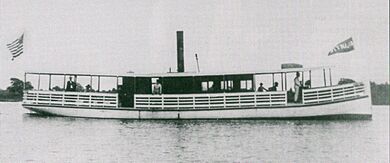
Many people called the time before the 1950s the "Quiet Years." Bethany Beach was hard to reach because there was no railroad. Visitors often had to travel by train, then by boat, and finally by carriage or motorboat to get there. This long journey meant fewer people visited Bethany Beach compared to other beach towns like Rehoboth Beach or Ocean City.
Because it was so remote, the people who lived in or regularly visited Bethany Beach knew each other well. The town remained a peaceful place. It was common to see fewer than 20 people on the wide beach at any given time. In its early years, the town also had religious rules, like no non-religious activities on Sundays. Even though Bethany Beach has become more modern, it still has a reputation as a "Quiet Resort."
During these years, Bethany Beach slowly added more services. A post office opened in 1904. A town newspaper, the Bethany Herald, started in 1904. The boardwalk was rebuilt in 1905 and again in 1912. A United States Lifesaving Service station opened in 1907, and the town was officially incorporated in 1909. A school was also established for younger students.
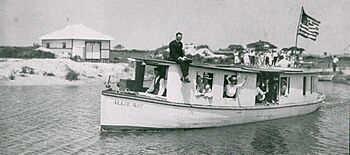
In 1915, the lifesaving station became a United States Coast Guard station. The Ringler Theater, which showed movies and hosted dances, opened in 1923. An electric lighting plant started in 1924, and the town began garbage collection in 1926. The first road connecting Rehoboth Beach and Bethany Beach opened in 1934.
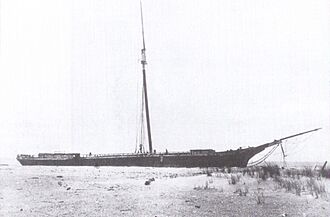
Storms sometimes caused damage. A storm in 1920 destroyed some beachfront houses and the original boardwalk, which was later replaced with a new, elevated one in 1923. Another big storm in 1933 caused flooding but no deaths.
World War II Era
World War II (1939-1945) brought changes. The road from Rehoboth Beach to Bethany Beach was paved in 1940. Starting in 1942, the town had to turn off its lights at night to protect ships from German submarines. The beach and boardwalk closed at 9:00 p.m. for military patrols. Many soldiers stayed in the town or nearby.
A severe storm in September 1944 destroyed the Ringler Theater and damaged the boardwalk, but the boardwalk was rebuilt later that year. After the war ended in 1945, Bethany Beach returned to its quiet ways. By 1946, all residents had water service, and in 1948, the volunteer Bethany Beach Fire Department was created.
Bethany Beach's Growth Years
The 1950s and Early 1960s
In 1952, the first part of the Chesapeake Bay Bridge opened. This made it much easier for people to drive to the Delaware coast from cities like Washington, D.C., and Baltimore. This led to a big increase in visitors and real estate development in Bethany Beach.
New communities like Sussex Shores and Middlesex Beach were built. South Bethany, a major new development, was built in 1962 and became its own town in 1969.
In 1961, the original Tabernacle, which was very old, was taken down.
The worst storm in Bethany Beach's history was the Ash Wednesday Storm of 1962. This powerful storm hit in March 1962 with strong winds and huge waves. It destroyed many beachfront buildings, including the boardwalk and town pavilion. Only one beachfront house in the southern part of town survived. Floodwaters reached far inland, and sand buried streets and cars. After the storm, the town rebuilt the boardwalk and made new rules for building houses on tall stilts to protect them from future storms.
From 1962 to 1979
Development continued after the 1962 storm. A new post office opened in 1965, and the town's first bank in 1966. Construction of Bethany West, a large new development, began in 1966–1967. A new town hall and police station opened in 1970.
Sea Colony, a large beach and tennis community with high-rise buildings, was planned in 1969. These buildings, the first and only high-rises in the Bethany Beach area, opened in the early 1970s. Many longtime residents were against Sea Colony because they wanted to keep the town quiet, but the development was built outside town limits.
Bethany Beach started using parking meters in 1974, which now help fund the town. In 1975, a sewerage system was installed, and roads were repaved. A bandstand was built on the boardwalk in 1976, where musical performances and events are still held today.
In 1976, a sculpture by Peter Toth was placed in town as a tribute to Native Americans. It caused some debate because there wasn't much Native American history in Bethany Beach itself.
The 1980s and 1990s
Bethany Beach had traditionally resisted selling alcohol. However, in 1982, the state allowed the first liquor license in town. The town now allows alcohol sales in restaurants but limits the number of bars and stops sales after 11:30 p.m.
In the early 1980s, the Bethany Beach Fire Department opened the town's first emergency medical center.
Hurricane Gloria hit Bethany Beach in September 1985, causing damage to the boardwalk. In 1989, a major project added more sand to the beach to protect it from erosion.
On January 4, 1992, a strong storm damaged the boardwalk and beachfront buildings. The Native American sculpture also leaned over. It was replaced in 1994 by a new sculpture called "Chief Little Owl."
The town's library, the South Coastal Library, opened in 1994. In 1995, the town started its "Concerts at the Beach" program. A new town hall and community center opened in 1997.
Severe storms in January and February 1998 caused significant beach erosion and flooding.
Since 2000
In 2001, Bethany Beach celebrated its 100th birthday and completed a new tabernacle. The "Chief Little Owl" statue, damaged by termites, was replaced by a new Native American sculpture by Peter Toth that same year.
Over the winter of 2008–2009, a large beach replenishment project added new dunes to the beaches. These dunes are tall and block some views of the ocean from the boardwalk, which has been a topic of discussion.
In November 2009, remnants of Tropical Storm Ida hit the town, destroying most of the new dunes and making the beach much narrower. Repairs were made after the 2010 summer season.
By 2011, Bethany Beach joined other communities in banning smoking on most of the beach and boardwalk areas.
More storms in October 2015 and January 2016 caused severe erosion and flooding. Officials announced that beach replenishment would happen in 2017.
Learning in Bethany Beach
Residents of Bethany Beach attend schools in the Indian River School District. In the past, during the "Quiet Years," students in grades one through six went to Bethany Beach School. After sixth grade, they would attend Lord Baltimore School in Ocean View.
Famous People from Bethany Beach
- Henry Clay Drexler, a Medal of Honor winner
- Liane Hansen, a journalist
- Butch Lewis, a boxing promoter
- Edward P. Lilly, a historian
Historical Places Nearby
The Indian River Life Saving Service Station, Poplar Thicket, and the Wilgus Site are all historic places near Bethany Beach. They are listed on the National Register of Historic Places.
Images for kids
See also
 In Spanish: Bethany Beach para niños
In Spanish: Bethany Beach para niños




